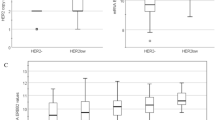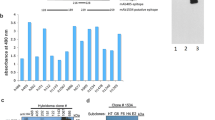Abstract
The Forkhead Box Protein 3 is highly expressed not only in regulatory T cells, but also in tumor cells, acting as a transcriptional repressor of breast oncogenes including HER2. We investigated the prognostic significance of Foxp3 expression in cancer cells in a large cohort of patients with HER2-overexpressing breast carcinoma treated with neoadjuvant chemotherapy. Foxp3-positive tumor cells were detected by immunohistochemistry in 103 patients with primary invasive HER2-overexpressing breast carcinoma, and treated with neoadjuvant chemotherapy, with or without trastuzumab. Kaplan–Meier analysis and Cox regression model were used to assess relapse-free and overall survival, respectively, and according to the presence or the absence of Foxp3 expression in tumor cells. Breast cancer cells were Foxp3+ in 57% of tumors. Foxp3 expression in breast cancer cells was associated with better relapse-free (P = 0.005) and overall survival (P = 0.03). By multivariate analysis, the presence of Foxp3+ tumor cells produced an independent prognostic factor for both better relapse-free (P = 0.006) and overall survival (P = 0.03). These findings indicate that the presence of Foxp3+ tumor cells represents a new independent prognostic factor of improved outcome in HER2-overexpressing breast carcinoma, which could help identify high-risk patients for additional therapies after neoadjuvant chemotherapy.


Similar content being viewed by others
References
Hori S, Nomura T, Sakaguchi S (2003) Control of regulatory T cell development by the transcription factor Foxp3. Science 299:1057–1061
Fontenot JD, Gavin MA, Rudensky AY (2003) Foxp3 programs the development and function of CD4+CD25+ regulatory T cells. Nat Immunol 4:330–336
Sakaguchi S, Ono M, Setoguchi R et al (2006) Foxp3+ CD25+ CD4+ natural regulatory T cells in dominant self-tolerance and autoimmune disease. Immunol Rev 212:8–27
Ghiringhelli F, Menard C, Puig PE et al (2007) Metronomic cyclophosphamide regimen selectively depletes CD4+ CD25+ regulatory T cells and restores T and NK effector functions in end stage cancer patients. Cancer Immunol Immunother 56:641–648
Curiel TJ, Coukos G, Zou L et al (2004) Specific recruitment of regulatory T cells in ovarian carcinoma fosters immune privilege and predicts reduced survival. Nat Med 10:942–949
Ko HJ, Kim YJ, Kim YS et al (2007) A combination of chemoimmunotherapies can efficiently break self-tolerance and induce antitumor immunity in a tolerogenic murine tumor model. Cancer Res 67:7477–7486
Dieckmann D, Plottner H, Berchtold S, Berger T, Schuler G (2001) Ex vivo isolation and characterization of CD4(+)CD25(+) T cells with regulatory properties from human blood. J Exp Med 193:1303–1310
Ghiringhelli F, Menard C, Martin F, Zitvogel L (2006) The role of regulatory T cells in the control of natural killer cells: relevance during tumor progression. Immunol Rev 214:229–238
Roux S, Apetoh L, Chalmin F et al (2008) CD4+CD25+ tregs control the TRAIL-dependent cytotoxicity of tumor-infiltrating DCs in rodent models of colon cancer. J Clin Investig 118:3751–3761
Karanikas V, Speletas M, Zamanakou M et al (2008) Foxp3 expression in human cancer cells. J Transl Med 6:19
Merlo A, Casalini P, Carcangiu ML et al (2009) FOXP3 expression and overall survival in breast cancer. J Clin Oncol 27:1746–1752
Zuo T, Liu R, Zhang H et al (2007) FOXP3 is a novel transcriptional repressor for the breast cancer oncogene SKP2. J Clin Investig 117:3765–3773
Zuo T, Wang L, Morrison C et al (2007) FOXP3 is an X-linked breast cancer suppressor gene and an important repressor of the HER-2/ErbB2 oncogene. Cell 129:1275–1286
Elston CW, Ellis IO (1991) Pathological prognostic factors in breast cancer. I. The value of histological grade in breast cancer: experience from a large study with long-term follow-up. Histopathology 19:403–410
Chevallier B, Roche H, Olivier JP, Chollet P, Hurteloup P (1993) Inflammatory breast cancer. Pilot study of intensive induction chemotherapy (FEC-HD) results in a high histologic response rate. Am J Clin Oncol 16:223–228
Black MM, Opler SR, Speer FD (1956) Structural representations of tumor-host relationships in gastric carcinoma. Surg Gynecol Obstet 102:599–603
Ladoire S, Arnould L, Apetoh L et al (2008) Pathologic complete response to neoadjuvant chemotherapy of breast carcinoma is associated with the disappearance of tumor-infiltrating foxp3+ regulatory T cells. Clin Cancer Res 14:2413–2420
Coffer PJ, Burgering BM (2004) Forkhead-box transcription factors and their role in the immune system. Nat Rev Immunol 4:889–899
Ormandy LA, Hillemann T, Wedemeyer H, Manns MP, Greten TF, Korangy F (2005) Increased populations of regulatory T cells in peripheral blood of patients with hepatocellular carcinoma. Cancer Res 65:2457–2464
Ichihara F, Kono K, Takahashi A, Kawaida H, Sugai H, Fujii H (2003) Increased populations of regulatory T cells in peripheral blood and tumor-infiltrating lymphocytes in patients with gastric and esophageal cancers. Clin Cancer Res 9:4404–4408
Bates GJ, Fox SB, Han C et al (2006) Quantification of regulatory T cells enables the identification of high-risk breast cancer patients and those at risk of late relapse. J Clin Oncol 24:5373–5380
Hinz S, Pagerols-Raluy L, Oberg HH et al (2007) Foxp3 expression in pancreatic carcinoma cells as a novel mechanism of immune evasion in cancer. Cancer Res 67:8344–8350
Ebert LM, Tan BS, Browning J et al (2008) The regulatory T cell-associated transcription factor FoxP3 is expressed by tumor cells. Cancer Res 68:3001–3009
Liu Y, Wang Y, Li W, Zheng P (2009) Activating transcription factor 2 and c-Jun-mediated induction of FoxP3 for experimental therapy of mammary tumor in the mouse. Cancer Res 69:5954–5960
Chen GY, Chen C, Wang L, Chang X, Zheng P, Liu Y (2008) Cutting edge: broad expression of the FoxP3 locus in epithelial cells: a caution against early interpretation of fatal inflammatory diseases following in vivo depletion of FoxP3-expressing cells. J Immunol 180:5163–5166
Wang L, Liu R, Li W et al (2009) Somatic single hits inactivate the X-linked tumor suppressor FOXP3 in the prostate. Cancer Cell 16:336–346
Lopes JE, Torgerson TR, Schubert LA et al (2006) Analysis of FOXP3 reveals multiple domains required for its function as a transcriptional repressor. J Immunol 177:3133–3142
McShane LM, Altman DG, Sauerbrei W, Taube SE, Gion M, Clark GM (2005) Reporting recommendations for tumor marker prognostic studies. J Clin Oncol 23:9067–9072
Gobert M, Treilleux I, Bendriss-Vermare N et al (2009) Regulatory T cells recruited through CCL22/CCR4 are selectively activated in lymphoid infiltrates surrounding primary breast tumors and lead to an adverse clinical outcome. Cancer Res 69:2000–2009
Nair S, Boczkowski D, Fassnacht M, Pisetsky D, Gilboa E (2007) Vaccination against the forkhead family transcription factor Foxp3 enhances tumor immunity. Cancer Res 67:371–380
Acknowledgments
This study was supported by Ligue contre le Cancer comité de Côte d’Or, Association pour la Recherche Contre le Cancer (ARC), Fondation de France INSERM AVENIR program and GERTI (Groupe d’Etude et de Recherche en Thérapeutique Innovante). Gregoire Mignot was supported by ARC (Association pour la Recherche contre le Cancer), and Julie Vincent by INCa (Institut National du Cancer).
Author information
Authors and Affiliations
Corresponding author
Rights and permissions
About this article
Cite this article
Ladoire, S., Arnould, L., Mignot, G. et al. Presence of Foxp3 expression in tumor cells predicts better survival in HER2-overexpressing breast cancer patients treated with neoadjuvant chemotherapy. Breast Cancer Res Treat 125, 65–72 (2011). https://doi.org/10.1007/s10549-010-0831-1
Received:
Accepted:
Published:
Issue Date:
DOI: https://doi.org/10.1007/s10549-010-0831-1




